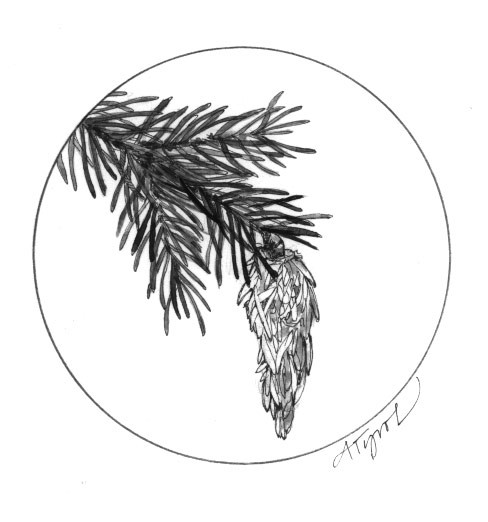
We brought our just-cut Christmas white spruce inside from the cold, nearby forest. Within the hour, little creatures, abruptly warmed, skittered across the living-room floor as I scrambled in pursuit, attempting to place them in plastic containers for study. The small, awakened folk were not interested in being confined, and more than a few vanished into the room’s cracks and corners.
Winter brings stress to most wild animals, often resulting in behavioral and metabolic languor. The spruce, within its branches of densely packed needles, had sheltered a diverse population of arthropods against freezing temperatures and accumulating snow. Brought indoors with the tree, they crawled free as their metabolisms rose.
Right away, a small moth fluttered into the warm air from deep among the branches.
Before studying my captives, I examined the spruce’s needles, twigs, branches, and the deeply recessed trunk. Here insect life was overwintering mostly in protected, insulated egg masses and pupae. A short stay in the house might have little effect upon some, but for others it could be a trigger initiating change and causing emergence prior to their normal time in the spring.
Stiff needles on one branch were decorated with little white flakes, each covering egg clusters of coccid scale insects destined to hatch out in a few months. Scale insects can be pests and even kill trees, but not in these limited numbers.
There were other insect eggs on the tree I didn’t recognize, although the familiar sac of an evergreen bagworm moth hung from one branch’s tip. The bag was covered with short lengths of twigs laid longitudinally and somewhat haphazardly. The silk-lined interior had once housed a flightless female moth who, before she died, laid yellowish eggs inside the case and then protectively plugged the opening with her expiring body. Hatching in the spring, larvae crawl away, eat, make their own bags, grow, and eventually pupate. Metamorphosed adult males emerge and fly off, leaving empty bags behind, but females remain enclosed in theirs, calling mates with pheromones released into the air.
A small, tattered orb web hung among several branches, but its unseen builder – likely an aranaeid spider inactivated by cold – probably was hunkered down under a web blanket tucked amidst the needles.
What emerged onto the floor in the first hours? A rove beetle, a click beetle, and a few native ladybird beetles, not those pesky Asian imports. Our cat spotted a brown-and-black woolly bear caterpillar rippling across the floor; it could only have come from the protection of the tree (which was not its food source). Now its destiny – turning into a striking Isabella tiger moth next spring – was in doubt.
High in the tree, a little sac-like bird’s nest hung from a twig close to the trunk, sheltered by a larger branch overhead. It was constructed of twigs, grasses, bits of feather, mosses, dried leaf fragments, part of a cocoon, lichens, and was lined with down and milkweed floss.
This was the nest of a ruby-crowned kinglet, a tiny bird frequenting our local conifers most months of the year. It had not been used for a long time, so the interwoven fibers now provided winter haven for small, shelter-seeking occupants. This may be where the rove beetle and click beetle had come from.
Teasing apart a portion of the nest revealed more. Several earwigs wriggled further in, while a male hunting spider dashed out with enlarged, sperm-transferring pedipalps held to the fore (but no female was in sight). A tightly coiled millipede seemed reluctant to undo itself and move – it had settled in for the winter. Closer inspection turned up a mite or two, but I couldn’t be sure how many, because they, or it, popped quickly in and out of the fibers.
Had this been a maple or other hardwood, the overwintering inhabitants might have been more populous and diverse, especially under loose bark and inside sapsucker and other woodpecker holes. Nevertheless, despite the spruce’s inhibiting resin and relatively unpalatable needles, its winter population was surprisingly varied and welcome to a cooped-up biologist. My wife, however, made sure I disposed of the small visitors.
I took the dispossessed specimens to a nearby treeline where I brushed away snow and scooped up chunks of leaf litter. I dumped my collection into the depression and covered it with a thick layer of leaves and insulating snow, then left, hoping for the best. Christmas is a time to be considerate of others, even the smallest amongst us, and it seemed to me that the gift of continued life was the least I could do for creatures rudely awakened after their winter quarters had been taken from the forest into unexpected warmth.

